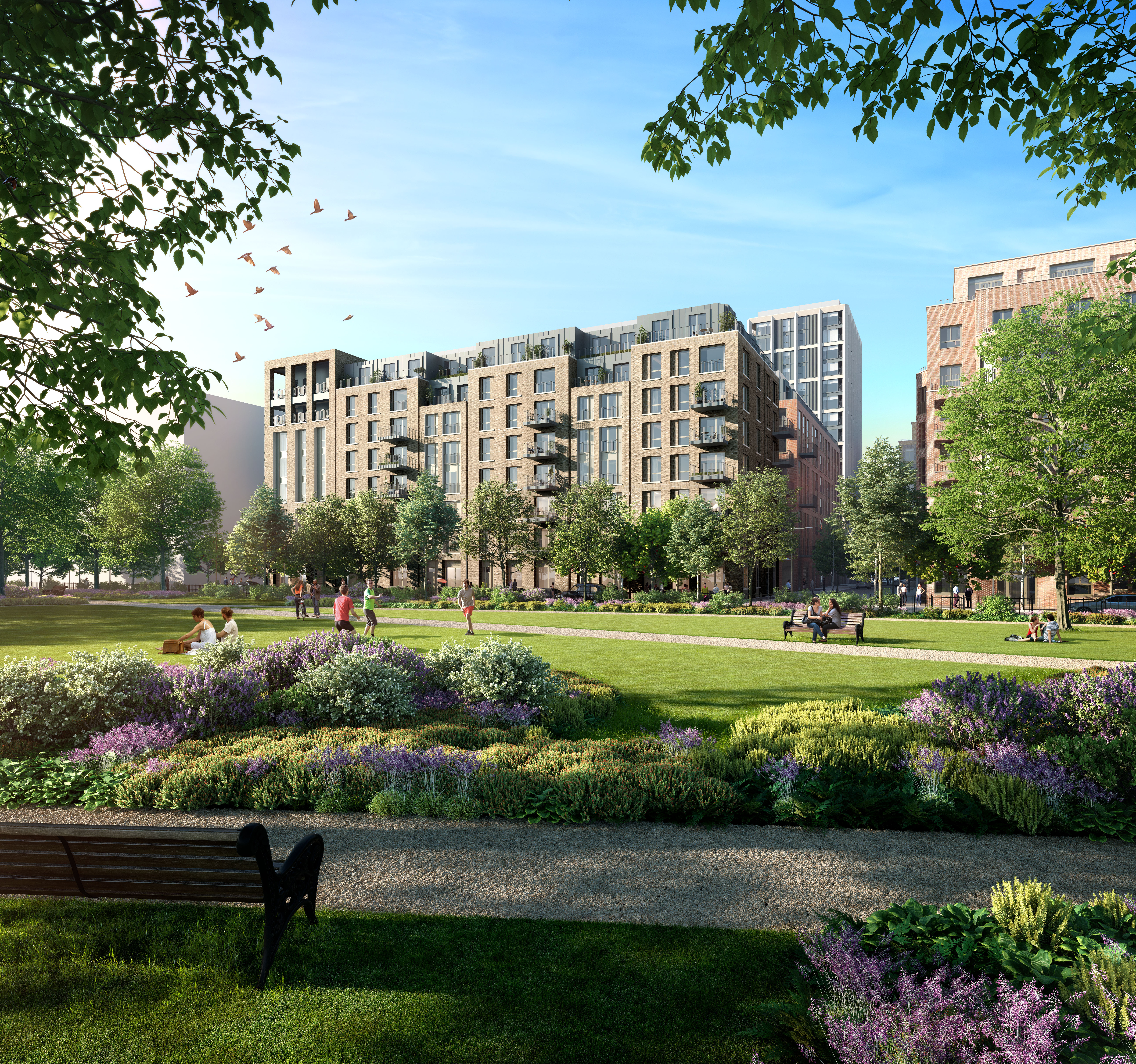Brent Cross Town

It has been over a decade since the first plan for the redevelopment of Brent Cross Cricklewood – a 373- acre area on both sides of the North Circular – was approved by Barnet Council and the Mayor of London. In 2015 Argent Related won an OEJU bid process to form a joint venture with the Council to deliver the southern portion of the site, known as Brent Cross Town. The area earmarked for change is currently 180 acres of light industrial uses, underused green spaces and a housing estate in a poor state of repair. It has a distinctly suburban character; ringed by large roads, its public transport (Northern Line and Thameslink stations) is not easy to access, and walking and cycling are not well provided for.
While Barnet as a whole is a relatively affluent borough, the level of deprivation (IMD data) in the wards immediately local to the Brent Cross Town site is higher than the Barnet average. At the heart of the development are the 40- acre playing fields, currently underused but with great potential as a dynamic centre for the new neighbourhood. With input from sporting bodies, play specialists, health professionals and landscape designers, they are being reimagined as an unrivalled hub for leisure and sports, with an emphasis on female sport, corporate health and wellness and team pursuits. In fact, this ethos of play – connection, participation and experimentation – has become the central theme of Brent Cross Town.
Describe the context and brief for this place?
It has been over a decade since the first plan for the redevelopment of Brent Cross Cricklewood – a 373-acre area on both sides of the North Circular – was approved by Barnet Council and the Mayor of London. In 2015 Argent Related won an OEJU bid process to form a joint venture with the Council to deliver the southern portion of the site, known as Brent Cross South (BXS), with this aspiration: “To create a living, thriving neighbourhood with a real sense of place….. a new town centre that will set the standard for developing successful new neighbourhoods in London.”
(Leader of Barnet Council, 2014) The area earmarked for change is currently 180 acres of light industrial uses, underused green spaces and a housing estate in a poor state of repair. It has a distinctly suburban character; ringed by large roads, its public transport (Northern Line and Thameslink stations) is not easy to access, and walking and cycling are not well provided for. While Barnet as a whole is a relatively affluent borough, the level of deprivation (IMD data) in the wards immediately local to the BXS site is higher than the Barnet average. Argent Related was chosen for its experience in shaping places that improve the existing physical environment and increase the social capital of their users. With BXS, it aims to deliver a new town centre that tangibly contributes to its people and to the planet, contributing to the overall wellbeing and economic development of the Borough.
Describe your design for this place and how it will contribute to urban life?
Brent Cross South’s aspiration is to be a place which encourages people to thrive, leading healthier lives, designed and built on a human scale, acknowledging that it is part of something bigger, with permeable edges and a sense of history and location, and which fosters communities that feel a sense of ownership in their neighbourhood. BXS’ design has a mix of uses, with residential buildings (all tenures), offices, schools, community spaces and retail and leisure coalescing around three main public spaces and a new high street, the ‘spine’ of the scheme. The design prioritises movement on foot or by two wheels; its streets comprise a mix of ‘fast lanes’ and smaller routes for slower walking and cycling.
Brent Cross South will have a varied line-up of shops, restaurants and experiential spaces on the high street, with tenants chosen for their ability to contribute something that enhances everyday life, either bricks and mortar amenities or concepts unique to north London. At the heart of the development are the 40-acre playing fields, currently underused but with great potential as a dynamic centre for the new neighbourhood. With input from sporting bodies, play specialists, health professionals and landscape designers, they are being reimagined as an unrivalled hub for leisure and sports, with an emphasis on female sport, corporate health and wellness and team pursuits. In fact, this ethos of play – connection, participation and experimentation – and its importance in human lives has become the central theme of Brent Cross South.
What was your process in coming up with the design? What research, consultation, workshops or conversations did you undertake?
Community engagement began in 2016 through multiple channels. To date: a project website which has had 15,000 visits; newsletters distributed to 17,000 homes; a Community Liaison Group of local stakeholders; eight exhibition events consulting on parks, community facilities and homes; a research project on the history and character of the area, now used to inform design; and an annual Community Fund supporting local initiatives celebrating or improving the local area, with community leaders on the distribution panel.
As part of the 2017 UKGBC’s Green Sky Thinking week the BXS team held a peer hackathon to interrogate wayfinding in the evolving masterplan with a group of 40 industry professionals. Participants took on a known issue – connections, access to green spaces, signage – and explored it with the end user in mind, resulting in refined plans and tangible prototypes which will be tested with residents in later phases.
In 2017 the team took part in an off- site day to interrogate the design of the plan’s streets and spaces. Facilitated by OpenCity, an observation walk in Peckham – a place with a diverse population, evolving organically and through development, with a mix of typologies and retail – was followed by a ‘persona-led’ focus on different user profiles. The exercise raised issues of safety, accessibility, interaction and disposable income, and illustrated the need for BXS to respond to them thoughtfully. Results included the redefinition of the high street, provision for smaller, less formal retail spaces, and reshaping the larger public spaces.
How does your design respond to future changes in demographics, transport and the climate emergency to create a resilient place?
BXS has an overarching social and physical sustainability strategy, developed as part of the master planning process, and clear targets to ensure it becomes a thriving, inclusive, planet-friendly, future-proof and truly co[1]curated place.
Physical environment
- Public transit-oriented design principles with a goal of 80% of journeys by public transport/on foot/by cycling by 2041
- District heat network with the aim of zero carbon heating within a generation
- An aspiration of reducing the embodied carbon of buildings by 65% by 2030
- Site-wide microclimate (air quality, noise, wind and sunlight) planning to inform public realm and building design.
Provision for people
- High-quality employment and lifelong learning opportunities
- Designed to accommodate multiple SMEs
- All outdoor play areas accessible to those of different abilities
- New community spaces
- Spaces for interim uses to test concepts for fun, play and social cohesion
- Tech, infrastructure and space to support a fixing and sharing economy: encouraging conscious consumer behaviour
- An aspiration for 40% of residents to reach ‘flourishing’ wellness levels – compared to the UK’s average of 20%.
Greening and nature
- Target of a minimum 20% biodiversity net gain and exemplar urban greening to support London’s National Park
City status – guidance supplied by London Wildlife Trust
- Nature interaction plan based on biophilic design principles
- 50% of the development will be green space
- 100% of homes within 300 metres of quality green space
-
Early bird entry deadline: 15 December 2023
-
Final entry deadline: 25 January 2024
-
Festival of Pineapples: 15-19 April 2024
-
Awards party, London: May 2024
© The Pineapples - Tweak Ltd. 124 City Road, London, EC1V 2NX. Tel: 020 3326 7238
